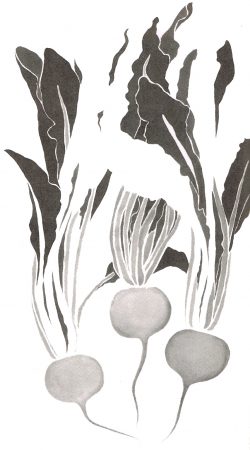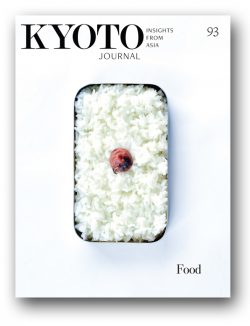Sometimes at night, I visited the master in his restaurant hidden among the nightclubs of Gion. As the last guests departed, I would just be coming in, and though I had my pick of any seat in the restaurant, I always chose the counter. After a while, the master came and sat down where he could oversee his apprentices as they prepared our supper. As he struggled with his daily accounts, he paused occasionally to tell me various things: historical vignettes, local customs, recipes.
“You know how to tell a good sobaya from a bad one? You can tell by the wasabi. A good sobaya always serves pure, freshly grated wasabi. Second-class restaurants serve wasabi mixed with wasabi daikon.”

“Wasabi daikon? What’s that?”
“Wasabi daikon and real daikon are two different things. Wasabi daikon is a lot cheaper and can be grown almost anywhere, but real wasabi has to be grown in mountain streams. They process this wasabi daikon in a factory in large quantities, and make a kind of flour out of it which is mixed with a little real wasabi and some green coloring to make it look better.”
“How can you tell whether you’re getting the real thing or not?”
“It’s not hard to tell the difference. Real wasabi is grated by hand so it has a kind of a lumpy texture. The daikon wasabi is made into a powder; no lumps, the texture is smooth and uniform. And another thing—it burns your throat.”
“Is any of this daikon wasabi grown around Kyoto?”
“Eh?” he said, as he laboriously entered figures in an old worn ledger. “Yeah, sure. There’s one farmer who grows this karami daikon on 300 square meters in Takagamine. He’s the only one.”
“Karami? I thought you said ‘wasabi daikon.’”
“Eh? No, I meant wasabi. It’s wasabi daikon.”
Despite the hangover I suffered the next day, I was sure that I had heard something like “karami” daikon mentioned by the master. I vaguely remembered a rather long and tedious description of the cultivation of wasabi daikon. Referring to Dr. Shiro Takashima’s Vegetable Crops of Japan In Color, I confirmed my suspicion that wasabi daikon was indeed a very mundane plant (horse radish), brought to Japan in the Meiji Era and, according to Dr. Takashima, unsuitable for Japanese cuisine.
After I got clear on the subject of horseradish vs. wasabi, I began to wonder about “karami” daikon. Why was it grown only in Takagamine? With a name like “karami” (karai—hot or spicy; mi—flavor), did it taste like wasabi or horseradish?
Again, Dr. Takashima set me straight. In another work, Kyoto Vegetables, he enumerates and describes in detail the histories of 33 different vegetable varieties that are peculiar to Kyoto or have originated in Kyoto. For example, the ebi imo (water caltrop) was derived from a kind of sato imo (a kind of sweet potato) brought to Kyoto in the late 1700’s; the Kamo eggplant, which seems to have originated in Fushimi or Takeda, slowly migrated up the Kamo River to its present cultivation site near Kamigamo Shrine; the Horikawa gobo (burdock root), was supposed to have sprung from the filled-in moat that surrounded the ruins of Hideyoshi’s Jurakudai; the now-extinct kori daikon was grown in Nishikyogoku from about 1600 until the Showa Era, when the demand began to “wane with the changing times,” and the last remaining seeds were lost during World War II. Among these rarities, unknown even to the people of Kyoto, I found karami daikon.
According to Takashima, the karami daikon has a history of cultivation extending back a thousand years. Originating in Haradani, a small valley behind Kinkakuji, it was cultivated there for hundreds of years by a few farming families. During the Edo period, it was introduced into Takagamine where, due to better soil conditions and selective breeding, it reached its present proportions—about the size and shape of a golf ball. It was adopted by the farmers of the area to such an extent that it soon became known as the meibutsu1 of Takagamine.
Detailed information about karami daikon’s past users or uses is largely lacking. The Emperor Chomei (d. 1383) is said to have been fond of it. It was considered good enough to offer to the Kamidono of Imamiya Shrine and for many years it was sold there as a cure for palsy and bubonic plague. The Shogunal Governor of Kyoto, Shigemune Itakura (d. 1656), wrote that he had served 500 of them at a banquet and found them very satisfactory. At the beginning of the Meiji Era, almost every farming household in Takagamine was growing karami daikon. By the beginning of the Showa Era, the number had dwindled to ten, and at present, there is only one farmer left who grows it.
I reminded Mr. Shimamoto of this as we sat talking in his high-ceilinged farmhouse in Takagamine, but he appeared to be rather unconcerned. As a farmer, it may seem commonplace that varieties of vegetables do not exist forever, but are in constant competition with each other for survival on our dinner plates, and that the development of modern agriculture and inter-regional (and now international) trade in produce have greatly accelerated this process.
“How long has the Shimamoto family been in Takagamine?” I asked.
“My family has been here for at least 200 years. This house was built about 50 years ago. Before that, there was a real old-style house, you know, with a thatched roof.”
“And during all this time, your family has been growing karami daikon?”
“As far as we know. We now grow about 15,000 plants a year.”
“Who do you sell them to?”
“Well, you know, you can’t buy it in the market. Haven’t been able to for a number of years. Our only customers are a few famous soba restaurants in Kyoto. It’s served with soba.”
“How many restaurants are using karami daikon?”
“Right now, there’s about six in Kyoto. The only restaurant that served it in Tokyo closed down last March.”
“So the entire demand for karami daikon is from six restaurants?”
“That’s right.”
Mr. Shimamoto showed me his 300-square-meter plot of karami daikon, near a precipice overlooking the Kamiya River. A mountain loomed across the valley.
“What’s the name of that mountain?” “That’s Washigamine (Eagle’s Peak).”
“Are we by any chance near Hideyoshi’s Great Dike2?”
“You’re standing on it. Used to be a bamboo grove over there, but I cut them down. This is where I grow karami daikon, right over here,” he said, pointing to a row of unlikely-looking plants with wilted leaves. “Those are for seed.”
At that moment, standing on top of Hideyoshi’s dike, a panoramic view of the mountain before us and the blue sky above, I thought; what a fine thing it must be to have a garden where you can grow your own vegetable.
“Why did the demand for karami daikon fall off so suddenly in the Showa Era?”
“A lot of sobaya in Kyoto went out of business during and after the war. Soba was hard to get, and people didn’t go out to restaurants much anyway. After the war a lot of people changed their jobs. Farmers around here stopped growing it, too. Seemed like it became too much trouble.”
“How about the shrine? When did they stop using it there?”
“Oh, that stopped about the same time, about thirty years ago.”
Even gods have to change with the times.
I forget when I first pushed aside the noren and went inside; probably after a ramble through northwestern Kyoto or a visit to one of the famous temples of Takagamine. The appearance of the Yamashiro is not remarkable, outside or inside, and the menu boasts nothing that couldn’t be found in a thousand similar neighborhood sobaya across the nation. Perhaps I didn’t notice the sign on the wall the first time I came there; in blue felttipped pen on yellow paper was written:
Karami Soba
Meibutsu of Takagamine
¥450
Served November through March
This time, I asked the master if he had ever heard of karami daikon.
“Karami daikon? Oh, yeah, my father used to grow the stuff. I was raised on it. My brother still grows it, in fact. We serve it here in our restaurant when it’s in season.” He pointed to the sign on the wall.
“Karami soba is like oroshi soba, only instead of ordinary daikon, we use grated karami daikon.”
“What does this karami daikon taste like?”
“It tastes like a turnip. Ordinary daikon has a slightly sweet taste to it, but karami daikon tastes slightly bitter. We call this horonigasa. Like the hops they put in beer. That taste plus the spiciness, that’s the taste of karami daikon.”
“How long can you keep them after they’re harvested?”
“If you put them in a dark corner of the refrigerator with the dirt still sticking to them, they last about ten days. After that, they start to lose their taste. So we only use it in season. November through March : only five months out of the year.”
“Who invented karami soba?”
“I don’t know that much about it’s history. I think it was just somebody in the soba business who said to himself, ‘I guess this’ll work, won’t it? Older people like it better. There’s a generation gap.”
“I see by the sign that you’re advertising karami soba made with karami daikon, the meibutsu of Takagamine. Are people around here aware that karami daikon is the local meibutsu?”
“Not really. Like I said before, it’s the older people who know about it and like it. Young people hardly know about it at all. I guess I should make an effort to advertise it more.”
“What do you think of the future of karami daikon?”
“As long as there are seeds, I’ll continue to use it. Till the day I die. As long as it’s available. It would be sad if the tradition died. I’d like to see it passed on to future generations.”
In the case of a vegetable, survival depends mainly on the number of people who eat it, thereby causing the farmer to grow more of it. If you are interested in helping to insure the survival of karami daikon, or if you just want to find out what it tastes like, the following restaurants serve “karami soba”:
Kawamichi (The honten only sells soba cookies now so go to the Fuyacho Branch map)
Shouan map
l. Meibutsu means “famous thing” or, in the vernacular usage “local specialty”. It usually refers to an agricultural product from a certain area that has become famous, presumably due to its intrinsic excellence. Most of the pre-Taisho suburbs of Kyoto have their own meibutsu. Matsugasaki in Sakyo Ward is still known for its tsukemono made of rape blossoms; the Nishiyama area has long been famous for bamboo shoots; and the area south of Kujo street used to be famous for green onions (“kujo negi”). The word meibutsu can refer to any food product, and also to a climatic feature of a certain region, a point of interest to sightseers, or even a well-known local character.
2. In 1591, Hideyoshi Toyotomi ordered a great wall built around Kyoto. The purpose was two-fold: to defend Kyoto against military attack , and to control flooding. The wall was destroyed by order of the Shogunate, but there are still some places in Kyoto where remnants may be seen.
KJ93: Food is out now.




